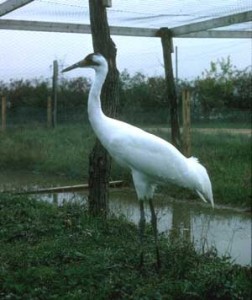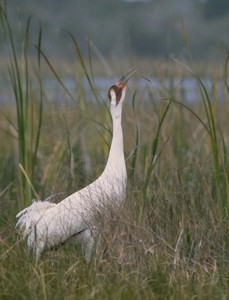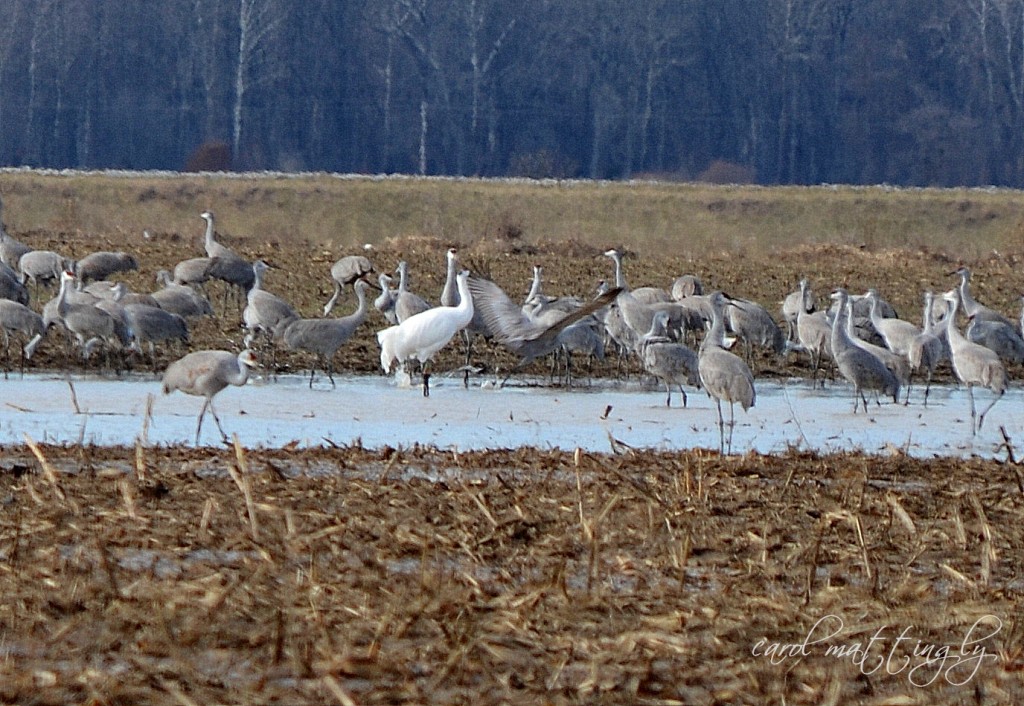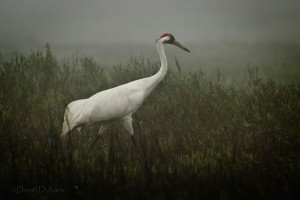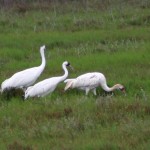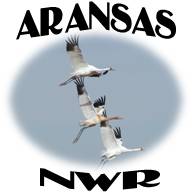Archive for the ‘Headline’ Category
CANUS – 186 whooping crane descendants
February 25, 2013Editor’s note: The Whooping Crane Conservation Association (WCCA) has received several inquiries during the past year quizzing us about why we believe whooping cranes are so cherished. One person wrote “who gives a dam about whooping cranes?” Answers to questions like these are not easy when you are responding to someone who is not interested in the natural world and all its wonders. Probably the best answer was written by Aldo Leopold in “A Sand County Almanac” -“There are some who can live without wild things, and some who cannot.” To further answer the questions, I reviewed a story we printed about Canus the whooping crane in “Grus Americana” (WCCA’s newsletter) in May 2003. A more detailed article about Canus appeared on Patuxent Wildlife Research Center web page. The article is posted below to provide an example of the “value” of one whooping crane and the people who cared for him. Hopefully this article will be read by a diverse group of people including United States Attorney’s, federal judges, wildlife law enforcement personnel, wildlife biologists, news reporters and citizens interested in whooping cranes:
CANUS and his 186 whooping crane descendants (1964 – 2003)
– USGS Author unknown. Written in 2003 –
To anyone who cares about endangered species, information about their numbers is always important. For whoopers, the rarest of all cranes, the annual count has been an environmental cliff-hanger for decades. In 1938, they were down to only 18 birds in the Aransas-Wood Buffalo flock, with only 11 remaining in the non-migratory Louisiana flock. Ten years later there were 31 birds in the Aransas-Wood Buffalo flock, but the Louisiana flock was down to a single bird. By 1950, the Louisiana flock was gone. The Aransas-Wood Buffalo flock’s numbers hovered on the edge of disaster for another decade. By 1964, there were still only 42 whooping cranes in the wild.
So, when a biologist doing aerial surveys in 1964 at Wood Buffalo Provincial Park (in Saskatchewan and Northwest Territories, Canada) discovered a young-of-the-year chick with a broken wing, he quickly took action. The chick’s parents were aggressive, rushing the helicopter when it came too close. The biologist knew that the parents could keep the chick safe from predators, but soon they would have to migrate, and their chick wouldn’t be able to follow them. He wouldn’t survive long once they were gone.
The biologist contacted officials in Canada and the US, and was advised to capture the bird. They did so the next day, chasing the chick through the marshland until it tripped on its dangling primaries and fell. The young crane, once captured, offered surprisingly little resistance. An x-ray showed a 2 inch sliver of charred wood had pierced the bird’s breast muscle and his wing was partially dislocated. They speculated that he had struck a burnt tree during early flight practice. To everyone’s surprise, the young crane showed no fear of his captors and readily accepted food including smelt, mealworms, hamburger and minced eggs.
The injured chick was later transferred to Monte Vista National Wildlife Refuge, Colorado where he did well until he suddenly became ill. Four veterinarians were brought in and treated the bird, who seemed near death. Amazingly, within a day the crane seemed to recover. But his bout of bad luck wasn’t over. While exercising in his pen one morning, he caught a toe in the bandage on his injured wing and fell, breaking the wing in two places. Again, the vets repaired the wing and he again recovered. It was shortly afterward that this young crane would be given the name “Canus” — CAN for Canada and US for the United States. A leg band was attached with the number “02-64001”.
In 1966, 02-64001 was transferred to what was then the beginnings of the U.S. Fish and Wildlife Service’s endangered species captive propagation program at the Patuxent Wildlife Research Center. 02-64001 was the first whooper in the program, and would become, over his long life, the foundation sire of the captive flock. His adjustment to life in captivity was a major factor in his ability to thrive in this new environment. Unlike many wild-caught animals, he never showed fear of his caretakers, and once he matured, would be quite aggressive to them, especially during breeding season.His injured wing would eventually be amputated. Without two fully functional wings, 02-64001 could not breed naturally. And so the biologists at Patuxent developed an Artificial Insemination (AI) program so that Canus, and other whooper males who were not fully-flighted, could reproduce. With such small numbers, every individual whooper was genetically valuable. As Patuxent’s endangered species program developed, eggs from Wood Buffalo were brought here to hatch, to develop a captive breeding flock that would genetically represent the wild flock in Aransas. This captive flock would be a safeguard — a genetic back-up — in case disaster wiped out the remaining wild birds.
Those early years were devoted to building the breeding flock and learning how to propagate whooping cranes. All the while, the numbers in the wild crept up slowly but surely. In 1966, when 02-64001 came to Patuxent Wildlife Research Center, there were 43 birds in the wild. In 1976, there were 69. Meanwhile, the scientists at Patuxent were discovering just how much there was to learn about the care, feeding, and propagation of whooping cranes.
All through the growth of Patuxent’s breeding flock, the development of proper incubation techniques, the perfecting of AI, the development of health care protocols, nutritional formulas, medical techniques, and chick rearing techniques, 02-64001 was there. Because he was such a long-term subject for Patuxent’s experiments, he literally taught us much of what we know about successful husbandry and breeding of captive Whooping cranes. He sired chicks with his mate through artificial insemination, and his semen was used here on many other female whoopers. It was even shipped, cryogenically preserved, to other facilities with whooping crane females.
Over the years, Canus and his mate raised many chicks together, and were fiercely protective parents. He was surprisingly healthy, after his initial rocky start, but he did have a bout of illness during the 1980s that he recovered from, and in the last five years he had some minor problems due to arthritis in his spine. We moved a panel heater into his pen in the hopes that would help and it may have, but we never actually saw him use it. He always knew when he was being observed. At the first site of humans approaching his pen, 02-64001 and Mrs. C would start going through their threat displays, letting everyone know that if they were thinking of coming in his pen, there would be trouble!
We first wrote about 02-64001 in these reports in June, 2000. At that time, we were following the progress of a young chick destined to be released in Florida, and 02-64001 was that chick’s grandparent. We also talked about some of Canus’ offspring who were now breeding adults in our program such as 02-84003 and 02-85001, our most productive pair, and also 02-83004 and 02-83003. Last year, we reported on Lucky, the first chick to fledge to wild whooper parents in the United States in 60 years — Lucky is a great-grandchild of Canus.
Over the course of his long life, 02-64001 was responsible for 186 whoopers, as sire, grand-sire, great-grandsire and beyond. That’s four times the number of whoopers who were alive the year he was captured. His descendants today are flying free from Wisconsin to Florida and reproducing naturally in the wild in Central Florida. Today, there are nearly 420 whooping cranes in the world — ten times as many as the year he was captured. 02-64001 was no small part of that. ( Approximately 600 whoopers exist in 2013 in the wild and I captivity.)
Early in the morning of Saturday, January 18, 2003, 02-64001 was found down in his feedshed near his heater. The technicians, Barb and Brian, experienced in emergency crane care, rushed him to the veterinary hospital on Center, and after placing him in a heated pen, contacted both the veterinarian on duty, Dr. Patty Bright, and our regular veterinarian, Dr. Olsen, who was attending crane meetings in California. In a short time, 02-64001 began to rally, lifting his head, looking around, and even attempting to stand. 02-64001 was only a few weeks shy of 39 years, and had had other sudden bouts of illness, but had always recovered, so we had hopes that this would follow that pattern. Dr. Bright treated 02-64001 with injectable fluids and steroids, and consulted with Dr. Olsen about an appropriate treatment regimen for the next few days. They decided to also administer antibiotics, and continue fluids and steroids until the bird was well enough for diagnostic blood work, which might tell them more about the nature of the problem.
Unfortunately, despite Canus’ attempt to rally, he died during treatment a few hours later. It was a terrible shock to all of us. In spite of his age, 02-64001 had always fought back against the odds and had always been so strong– it was hard to imagine anything defeating him.
To the people who care about the fate of endangered species, the numbers of animals is a natural focus. How few, how many. For those of us who work with these rare animals, each individual under our care is special, unique to themselves, and valuable. In the course of our daily work, we discover their personalities, their individual quirks, and become totally involved in their welfare and that of their offspring. In many ways, 02-64001 embodied our mission — he survived against incredible obstacles, thrived, and showed a wonderful spirit and will to live. Even while we grieve his loss, we have to celebrate the success that was his life. And in the offspring he has left us, he’ll live on, both here at Patuxent, and free in the wild.
UPDATES
Lucky, the whooper who fledged this year (2003) to wild parents in central Florida (these birds are part of the non-migratory flock that lives in Florida year round), has separated from his parents and is living on his own. It’s normal for young birds to separate from their parents a few months before breeding season. Lucky is associating with wild sandhills and whoopers, and picking good habitat. He has his own radio transmitter so that the Florida biologists can keep track of him. He should be almost completely white by now. * Unfortunately, Lucky was killed by a bobcat in 2010. To see a two part video about Lucky click on: https://whoopingcrane.com/whooping-crane-videos/ Then select “Lucky the Whooping Crane” (be sure and watch both Parts 1 and 2).
After reading the article and viewing “Lucky the Whooping Crane”, we trust that you will understand why many cherish these birds.
Whooper Updates from The Aransas Project
February 16, 2013by Ron Outen, Regional Director, The Aransas Project, Feb. 16, 2013
USFWS Releases 2012-2013 Whooping Crane Estimate
USFWS has posted their 2012-2013 Winter Whooping Crane Survey. USFWS estimates the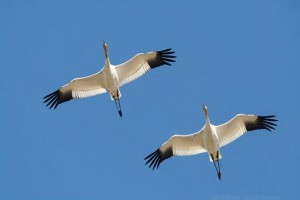 flock size to be 257 birds using their new distance sampling method. This estimate does not reflect an actual count of the flock size, but instead offers a 95% probability that the actual flock size is somewhere between 178-362 birds.
flock size to be 257 birds using their new distance sampling method. This estimate does not reflect an actual count of the flock size, but instead offers a 95% probability that the actual flock size is somewhere between 178-362 birds.
TAP issued this statement by Regional Director Ron Outen in response to the release of the estimate: “With the new flock-estimation methodology, there will be no more actual counts of individual birds. By their own analysis, USFWS offers a 95% probability that the actual flock size is somewhere between 178-362 birds. TAP remains concerned that the level of uncertainty with this sampling method is unacceptably high for a population this size. Additionally, the method fails to locate territories or detect mortality—all valid concerns raised by former Whooping Crane Coordinator Tom Stehn.
More fundamentally, the community—both locally and internationally—has come to expect an accurate count of the cranes and flock size year to year on the wintering grounds. We urge that USFWS reinstitute an actual census of the cranes in addition to this new methodology until it can be further peer reviewed and refined to ensure accuracy.”
Shootings of Whooping Cranes Highlight Other Risks to Flock
Two recent articles highlight the variety of threats faced by whooping cranes, both as they migrate to and from the wintering grounds in and around Aransas National Wildlife Refuge and once they arrive.
The Whooping Crane Conservation Association recently posted a release from the U.S. Attorney’s Office, District of South Dakota, entitled “South Dakota Man Guilty of Whooping Crane Murder.” The release detailed the sentencing of a South Dakota man who pled guilty to the April 2012 killing of an adult male whooping crane. The release notes that:
“The whooping crane killed in this case was one of about 300 wild whooping cranes that migrate from wintering grounds along the gulf coast of Texas to the Wood Buffalo State Park located in Alberta and the Northwestern Territories of Canada. This population of whooping cranes is the only self-sustaining population in the world.”
The plea resulted in the man being sentence to $85,000 in restitution, 2 years of probation, a $25 assessment to the Victim Assistance Fund, forfeiture of the rifle used, and a 2-year ban from hunting, fishing or trapping.
Closer to home,it was recently reported that a duck hunter turned himself in to a game warden in Aransas County in connection with the accidental shooting of a juvenile whooping crane in January of this year on St. Joseph’s Island. According to the report, the hunter believe that the juvenile was a sandhill crane, and turned himself in when he discovered that it was a juvenile whooping crane.
Former Whooping Crane Coordinator Tom Stehn notes that the Aransas National Wildlife Refuge is in the process of opening the Matagorda Island marshes to waterfowl hunting, and suggests that perhaps hunters should be required to take an online identification course to better protect the whooping cranes.
International Crane Foundation to Get $85,000 Restitution
February 14, 2013by Chester McConnell, Whooping Crane Conservation Association
On Friday, April 20, 2012, the Whooping Crane Conservation announced that a whooping crane from the Aransas/Wood Buffalo flock had been killed in South Dakota. This bird was a member of the only remaining wild flock of whoopers in the world. In 1950 only 14 cranes from this flock remained. They were carefully managed and protected by the U.S. Fish and Wildlife Service and Canadian Wildlife Service with assistance from the Whooping Crane Conservation Association. This flock has slowly increased and about 300 whoopers are in this flock today.
The Whooping Crane Conservation Association posted a $10,000 Reward for the conviction of any individuals responsible for the killing of the whooping crane (see Reward notice below). Later, U.S. Fish and Wildlife Service agents independently determined that Jeff Blachford, Miller, South Dakota had killed the whooping crane and Blachford was indicted by a federal grand jury on June 12, 2012.
Yesterday the hearing for Blachford was completed. United States Attorney Brendan V. Johnson announced that the Miller, South Dakota man pled guilty and was sentenced for killing an endangered whooping crane. Jeff Blachford, age 26, appeared before U.S. Magistrate Judge Mark A. Moreno on February 13, 2013 and pled guilty to one count of violating the Federal Endangered Species Act. Blachford was sentenced to $85,000 in restitution, 2 years of probation, and a $25 assessment to the Victim Assistance Fund. Blachford was additionally ordered to forfeit the rifle he used in the offense and is prohibited from hunting, fishing, or trapping anywhere in the United States for two years.
According to U.S. Attorney Meghan Dilges the $85,000 in restitution will be made to the International Crane Foundation.
The following Reward was posted by Whooping CranrConservation Association in April 2012:
Whooping Crane Shot – $10,000 Reward
by Chester McConnell, Whooping Crane Conservation Association
The Whooping Crane Conservation Association will pay a reward not to exceed $10,000 to anyone who provides information which leads to the conviction of any individuals responsible for the killing of a whooping crane which took place on the afternoon of Friday, April 20, 2012 along 354th Avenue, approximately 17 miles southwest of Miller, S.D. The purpose of the reward is to encourage the public to share information they might have about criminal activities involving whooping cranes. Federal, State, Provincial, and other public law enforcement personnel, and criminal accomplices who turn “states” evidence to avoid prosecution, shall not be eligible for this reward. If more than one informant is key to solving a specific case, the reward will be equally divided between the informants. 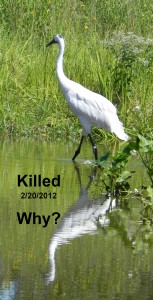
A reward has also been offered by the U.S. Fish and Wildlife Service for information leading to the arrest and conviction of the person responsible for the shooting of the whooping crane. Law enforcement officers from the Service and the South Dakota Game, Fish and Parks are investigating the shooting, which took place on the afternoon of Friday, April 20, 2012. The migrating adult whooping crane was traveling with two additional whooping cranes before being shot with a high-power rifle as it was standing in a corn field.
Anyone with information should call either the 24-hour “Turn in a Poacher Hotline” at 1-888-OVERBAG (683-7224) or the U.S. Fish & Wildlife Service at 605-224-9045 to report any information which will aid officers in the apprehension of the shooter. Callers can remain anonymous.
Eleven whooping cranes of the experimental Eastern Migratory population and non-migratory Louisiana population have been shot in the last two years. The Alabama case of January, a year ago, is still active. The Louisiana shootings have been solved by State Law Enforcement personnel and a reward will not be involved. One case is still active in Indiana.
The Whooping Crane Conservation Association will continue to provide rewards for killing of whooping cranes in the Aransas/Wood Buffalo flock.
South Dakota Man Guilty of Whooping Crane Murder
February 14, 2013Miller Man Sentenced for Killing endangered species
February 13, 2013, U.S. Attorney’s Office, District of South Dakota; Contact: Ace Crawford, 605-343-2913 ext. 2101
United States Attorney Brendan V. Johnson announced that a Miller, South Dakota man pled guilty and was sentenced for killing an endangered whooping crane.
Jeff Blachford, age 26, appeared before U.S. Magistrate Judge Mark A. Moreno on February 13, 2013 and pled guilty to one count of violating the Federal Endangered Species Act. Blachford was sentenced to $85,000 in restitution, 2 years of probation, and a $25 assessment to the Victim Assistance Fund. Blachford was additionally ordered to forfeit the rifle he used in the offense and is prohibited from hunting, fishing, or trapping anywhere in the United States for two years.
“Wildlife is an important resource to the people of South Dakota. This year marks the 40th anniversary of the Endangered Species Act, and the sentence handed down today for the senseless killing of a whooping crane, one of the rarest birds in the world, is a prime example of the enforcement of that law,” said Johnson. “The Department of Justice works hand in hand with the U.S. Fish and Wildlife Service and takes the killing of endangered species very seriously. Let this case serve as notice to anyone who thinks otherwise.”
In April 2012, Blachford shot and killed an adult male whooping crane approximately 17 miles southwest of Miller. “The killing of this whooping crane was a senseless act and the U.S. Fish and Wildlife Service is pleased with the sentence handed down in this case,” said Deputy Chief Edward Grace of the U.S. Fish and Wildlife Service Office of Law Enforcement. “The protection of endangered species is a high priority for the U.S. Fish and Wildlife Service and our Special Agents, in partnership with the South Dakota Department of Game, Fish and Parks, will continue to aggressively investigate these types of violations to ensure these animals receive the protection they need to survive.”
Whooping cranes are one of the rarest birds in the world with a total population of approximately 600 individuals. The whooping crane killed in this case was one of about 300 wild whooping cranes that migrate from wintering grounds along the gulf coast of Texas to the Woods Buffalo State Park located in Alberta and the Northwest Territories of Canada. This population of whooping cranes is the only self-sustaining population in the world.
This investigation was conducted by the U.S. Fish and Wildlife Service Office of Law Enforcement and the South Dakota Department of Game, Fish and Parks. Assistant U.S. Attorney Meghan N. Dilges prosecuted the case.
First Incidental Take Permit for Whooping Cranes at an Individual Wind Farm
February 7, 2013by Chester McConnell, Whooping Crane Conservation Association
The U.S. Fish and Wildlife Service (FWS) is considering issuing the first-ever Incidental Take Permit to a wind farm for endangered Whooping Cranes and threatened Piping Plovers. If FWS grants the permit, the Merricourt Wind Power Project in North Dakota would be protected from prosecution under the Endangered Species Act (ESA) for killing Whooping Cranes and Piping Plovers.
Whooping Crane Conservation Association contends that: 1) FWS failed to give the public adequate notice on an important endangered species issue, 2) the agency is only preparing an Environmental Assessment for a precedent-setting take permit of significant environmental impact, and 3) there are fewer than 300 individual Whooping Cranes left in the wild Aransas/Wood Buffalo flock which migrates through North Dakota.
The Merricourt Wind Project proposes to build 100 turbines within a 22,400 acre project area and build 33 miles of access roads. FWS has advised the project developer that the wetland stopover habitat in the project area is critical to the survival and recovery of the Whooping Crane. The site is also about two miles from designated critical habitat for Piping Plovers. In addition, FWS has told the developer that three ESA candidate species may be present at the site (Sprague’s Pipit, Dakota skipper, and Powesheik skipperling).
Whooping Crane Conservation Association president Brian Johns recently wrote a letter to the project manager explaining the Association’s position. President Johns wrote: “The Whooping Crane Conservation Association (WCCA) would like to express our concerns over the placement of the proposed Merricourt Wind Power Project in North Dakota. Wind Power projects have been identified in the International Recovery Plan for the Whooping Crane as a potential threat to flying Whooping Cranes. As you know the Whooping Crane is listed as Critically Endangered by the IUCN as well as both the United States Fish and Wildlife Service and the Canadian Wildlife Service. The Aransas/Wood Buffalo population (AWBP) which contains fewer than 300 individuals is the only self-sustaining wild population of whooping cranes. With such a limited population, the genetic contribution of each individual is critical to the survival of the species.”

The Merricourt Wind Project proposes to build 100 turbines within a 22,400 acre project area and build 33 miles of access roads.
John’s letter continues: “The proposed placement of this wind power project directly within the migration corridor of the AWBP seems like an accident waiting to happen. We understand that the USFWS may grant an Incidental Take Permit, which would allow the project to proceed. The WCCA is opposed to locating any wind power projects within the migration corridor. If such a project were to proceed, we would expect the USFWS to ensure that all mitigation measures listed in the Whooping Crane Wind Development Issue Paper are taken to avoid harm to the AWBP of Whooping Cranes.”
Brian Johns New President of Whooping Crane Conservation Association
February 4, 2013Brian Johns of Canada has assumed the role as President of the Whooping Crane Conservation Association for 2013. Brian replaced Lorne Scott. Scott, also a Canadian, will remain as a Trustee with the Association.
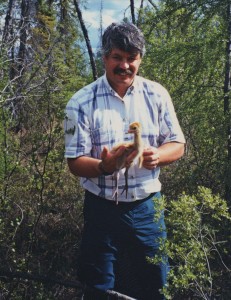
Brian Johns, Canadian Wildlife Service (retired) with whooping crane chick, Wood Buffalo National Park. Brian was recently elected as President, Whooping Crane Conservation Association.
Brian Johns is a retired wildlife biologist with the Canadian Wildlife Service (CWS). He received his Bachelor of Science Advanced degree from the University of Saskatchewan in 1973 and began his career with the CWS that same year. During his time with the CWS Brian conducted research on sandhill cranes, whooping cranes, loggerhead shrike and various songbirds in the grasslands, parklands and boreal forests of Alberta, Saskatchewan and Manitoba.
In 1981 Brian began monitoring whooping crane migration through prairie Canada and participated in the whooping crane radio tracking program. Between 1984 and 1987 he researched habitat use by migrant whooping cranes. Brian began directing the CWS whooping crane program in 1992 and has been involved in research and monitoring studies of Whooping Cranes on the breeding grounds in Wood Buffalo National Park and along their migratory flyway.
Brian’s research has included population monitoring, philopatry, effects of egg collection and the banding of juvenile whooping cranes. Brian has also studied potential reintroduction habitat in Saskatchewan and Manitoba and tracked sandhill crane migration routes from those habitats. He has logged over 1500 hours of aerial surveys over the crane nesting area.
Brian is the past chair of the National Loggerhead Shrike Recovery Team and Canadian Whooping Crane Coordinator. He co-chaired the Canada/United States Whooping Crane Recovery Team from 1995 – 2009. He is the recipient of Nature Saskatchewan’s Conservation Award and the Whooping Crane Conservation Association’s Honor Award and the Jerome Pratt Whooping Crane Award. Brian retired in 2009 after 36 years with the CWS.
Operation Migration On Estimating Whooper Numbers
February 2, 2013Operation Migration’s “In The Field” web page explains, “Debate continues in the Whooping crane world about the methods US Fish and Wildlife Service is now using to count Whooping cranes at the Aransas National Wildlife Refuge.”
“For almost 30 years, retired Whooping Crane Coordinator, Tom Stehn made a direct count of each bird while flying transacts over the refuge. The accuracy of that method was questioned because birds may move between the aircraft passes and been counted more than once.”
“The new system employed since Stehn’s retirement is called ‘distance sampling’. It consists of making multiple parallel survey flights over a large area and applying a formula to the number of cranes spotted to come up with a population estimate.”…
“The concern is that distance sampling is generally used to estimate the size of large populations and there are fewer than 300 Whooping cranes at Aransas. Many feel that a direct count could provide a more accurate number.”
To read the complete article, click on: http://operationmigration.org/InTheField/2013/02/01/controversy-heats-up/
Photographing a Whooping Crane
January 22, 2013Editor’s note: Our members and viewers of our web site often write us about their observations of whooping cranes. Some even send us photos. We always appreciate these. We enjoy sharing some of these submissions with you. We just received some photographs from Carol Mattingly. She also wrote about her experience. Her article is posted below. If you have interesting experiences and photos and would like to have us place them on the web site, please go to our web site whoopingcrane.com . Then click on “Report A Sighting” and fill out the form and click “Send”.
Photographing a Whooping Crane
By Carol Mattingly, Carol Mattingly Photography
Turning left onto a two lane dirt farm road, I edged my car just past an unplowed field and there standing in several inches of water picking at the ground in hopes of finding food was a beautiful adult Whooping Crane. How he could possibly find anything to eat in this field made me wonder. This region had just experienced the most severe drought in recorded history just this past summer. The seeds planted in these fields could not possibly have yielded any crops. Possibly weed seeds and insects were there.
It was a sunny Sunday afternoon and I had made my way to south Indiana just on the other side of a river bridge. The Bottoms is generally what the locals call this area. And after heavy rains the week before, I could see why it is called bottomland. There were large pools of standing water in all of the fields.
And for as far as the eye could see, on this particular Sunday, there were hundreds and hundreds and hundreds of Sandhill Cranes. And standing amongst the Sandhills was this one solitary Whooping Crane. I wondered if it had mated with one of the Sandhill Cranes and would it be traveling with this huge flock of Sandhill Cranes for years to come.
Seeing my first Whooping Crane was a fantastic treat, but getting a fairly decent image of the crane was ever better. I did not want to get too close for fear of frightening the birds. The Whooping Crane stood for some time looking around and I knew that was my opportunity to snap a few images. I love the way the Sandhill Cranes feathers lay across the back of their rump in a poof. But this Whooping Crane’s white feathers lying across his rump was so beautiful. I wonder if he knew he was the star of the show that Sunday. See my photo below:
The Man Who Saved the Whooping Crane
January 13, 2013Preface: After having read Kathleen Kaska’s book, “The Man Who Save the Whooping Crane: The Robert Porter Allen Story”, I needed to know more about this man who, if it hadn’t been for his dedication and perseverance, there probably wouldn’t be whooping cranes today.
While searching for every morsel of information pertaining to the whooping cranes before and during Allen’s time, I often thought of what a wonderful adventure and treasure hunt Kathleen must have had doing her research for the book. I contacted Kathleen to ask if she would like to write a short article outlining her feelings and experiences while researching “The Man Who Saved the Whooping Crane”. Immediately, she responded with “yes” and that she would love to. Below is an account of her adventures, which she has graciously written for us.
Thank you, Kathleen for sharing the life of Robert Porter Allen and your adventures of researching and writing the book.
Pam Bates, Whooping Crane Conservation Association ———————————————-
The Man Who Saved the Whooping Crane: The Robert Porter Allen Story
by Kathleen Kaska
By the time I began writing about the life and adventures of Robert Porter Allen, several decades had passed since he traipsed through the Canadian wilderness in search of the whooping crane’s last nesting site.
I first became aware of Allen’s work while designing an environmental/ecology unit for my
seventh-grade science class. The school librarian provided me with a National Geographic video about the efforts that had been made to save the whooping crane from extinction. The video briefly touched on Allen’s contributions, but it was enough to peak my interest. A few weeks later, I headed for the Texas coast to see the cranes on their wintering grounds at the Aransas National Wildlife Refuge. I’ll never forget that cold morning when I stood on the deck of the Wharf Cat tour boat gazing at those majestic birds through my binoculars—they simply took my breath away and at that moment I, too, wanted to make a difference in the whooping crane’s survival.At the time, I was also writing for Texas Highways magazine. When I returned home, I fired off a query to the editor, offering to write a story about Allen and the plight of the cranes. While researching the article, I realized that Allen had all but been forgotten. I felt his contribution to the world of ornithology and his story about his efforts to save the whooping cranes were too important to be lost. I decided to turn my research into a book.
Allen died in 1963. Considering all the time that had passed, finding someone who knew him well enough to paint a vivid picture of the Audubon ornithologist seemed an impossible task. I called the Florida Audubon chapter, located at the Tavernier Science Center, and learned that his daughter, Alice Allen, was living in Tavernier. I called her and introduced myself and told her about my plans. A few weeks later, I was on a plane to Florida.
Alice was only a young girl at the time her father had been named the director of the Whooping Crane Project in 1946. She was most generous in sharing her recollections of her father’s work, but I needed a wider perspective. I then visited the Science Center where most of Allen’s correspondences, published articles, photographs, and hand drawn maps are kept. Thanks to resident biologist, Pete Frezza, I even had the opportunity to motor out into Florida Bay to Bottlepoint Key where Allen had conducted his spoonbill research in 1939.
I had enough information to write the book proposal, which I eventually sent to University Press of Florida. By the time I received word of the book’s acceptance, my husband and I were on a two-year across-country retirement trip. Coming along with us on the trip, and taking up too much space in the truck of our car, were my research notes, tapes, and books. Over the next several months, I wrote the book in while on the road.
After it’s publication, I began giving presentations, which I entitled “On the Trail of a Vanishing Ornithologist,” named after Allen’s award-winning book, On the Trail of Vanishing Birds. That road trip provided me with the opportunity to visit sites I was writing about: Allen’s hometown in South Williamsport, Pennsylvania, Cornell University where Allen was enrolled in the early 1920s, Hopper’s Landing in Texas where Allen lived while working on the Aransas National Wildlife Refuge, and what proved to be invaluable, a second trip to see Alice and visit the Tavernier Science Center. Alice had uncovered more photos and information. Dr. Jerry Lorenz, the director of the Audubon Center and Flamingo Research Project and Allen successor twice removed, provided me with Allen’s research journals. These journals not only contained detailed accounts of his research, but also personal information; his feelings about being away from home and missing his family; his frustration with delays in moving forward with the Whooping Crane Project; his views on captive breeding program; anecdotes of his travels, which gave me a greater insight to his charismatic personality and sense of humor.
Most of the locations we visited were on our agenda. However, one particular serendipitous event led to an unbelievable experience. While traveling through Florida just south of Tallahassee, we noticed Wakulla Springs State Park, a hot spot for birding, was only a few miles away. We made a slight detour and upon arrival, checked into the historic Wakulla Spring Lodge for a two-night stay.
That afternoon on the birding boat tour, I met Betty and Lou Kellenberger, wildlife photographers and whooping crane devotees. They told me about the Whooping Crane Festival coming up that weekend at St. Mark’s National Wildlife Refuge. Representatives from Operation Migration (OM) and the International Crane Foundation (ICF) were speaking. That’s all I needed to hear. We added two more nights to our stay so I could attend. Although I missed seeing OM ultralight pilot, Brooke Pennypacker, I met Joan Garland with ICF. I told her about my book and she invited me to tour the ICF in Baraboo, Wisconsin later that year.
Looking at our map and calendar, I realized the Necedah National Wildlife Refuge, the location where OM trains whooping crane chicks to migrate, was nearby and that we’d be driving through the area during the time the Class of 2012 chicks would be training. About a week before we arrived in Wisconsin, I emailed Joan and asked if we could watch one of the training exercises. She made a few phone calls, and on the morning of August 12, my husband and I stood in a bird blind with pilot Richard van Heuvelen and lead technician Barb Clauss, both dressed in crane costumes, as they explained the morning’s training plan. Richard left to revive up the ultralight while Barb prepared to released the chicks. Watching those gangly young whoopers rush out of their pen and take to the air was one of the best moments of my life. I had to choke back tears. My husband, who’d spent years listening to me talk about OM, turned to me and said, “Now, I get it.” There were tears in his eyes, too.”
Visiting these sites, discovering Allen’s journal, and watching those chicks fly was just what I needed to give The Man Who Saved the Whooping Crane: The Robert Porter Allen Story, that special emotional element to transform the book from a mere biography into a true-life adventure story.
The book was released on September 16, 2012. Shortly afterwards, I received word that it had been nominated for the George Perkins Marsh Award for Environmental History.
Here’s an excerpt of the book:
It was April 17, 1948 in the early hours of a muggy Texas morning on the Gulf Coast. The sun at last burned away the thick fog that had settled over Blackjack Peninsula. The world’s last flock of wild whooping cranes had spent the winter feeding on blue crab and killifish in the vast salt flats they called home. During the night, all three members of the Slough Family had moved to feed on higher ground about two miles away from their usual haunt. The cool, crisp winter was giving way to a warm balmy spring, the days were growing longer, and territorial boundaries were no longer defended. Restlessness had spread throughout the flock.
As Robert Porter Allen drove along East Shore Road near Carlos Field in his government issued beat-to-hell pickup, he spotted the four cranes now spiraling a thousand feet above the marsh. He pulled his truck over to the roadside and watched, hoping to witness, for the first time, a migration takeoff. One adult crane pulled away from the family and flew northward, whooping as it rose on an air current. When the others lagged behind, the crane returned, the family regrouped, circled a few times and landed in the cordgrass in the shallows of San Antonio Bay. It was Allen’s second year at the Aransas National Wildlife Refuge. He had learned to read the nuances of his subjects almost as well as they read the changing of the seasons.
In the days preceding, twenty-four cranes left for their summer home somewhere in Western Canada, possibly as far north as the Arctic Circle. This annual event, which had been occurring for at least 10,000 years, might be one of the last unless Allen could accomplish what no one else had. The next morning when Allen parked his truck near Mullet Bay, the Slough Family was gone, having departed sometime during the night. That afternoon, he threw his gear into the back of his station wagon and followed.
THE MAN WHO SAVED THE WHOOPING CRANE: THE ROBERT PORTER ALLEN STORY—September 2012: University Press of Florida
Total Whooper Population Count Urged
January 6, 2013by Chester McConnell, WCCA
Whooping Crane Conservation Association (WCCA) president Lorne Scott has urged Secretary Ken Salazar, U.S. Department of the Interior to resume regular aerial total population counts of whooping cranes on Aransas Refuge. The aerial census of the total whooping crane population has been used for the past 61 years. During 2012, the U.S. Fish and Wildlife Service decided to convert to a statistical survey method using hierarchical distance sampling. In a letter to Secretary Salazar, President Scott writes, “The WCCA sees the total count census as the most practical, economical and having the most scientific value”. Citing the Service’s “2011-2012 estimate of 254 plus or minus 62 Whooping Cranes”, Scott wrote, “This degree of uncertainty for a critically endangered species is simply unacceptable. President Scott’s letter is posted below:
January 4, 2013
Ken Salazar,
Secretary U.S. Department of the Interior
1849 C Street NW
Washington, DC 20240Dear Mr. Salazar:The annual winter census of endangered Whooping Cranes has been an event looked forward to by the conservation community since Aransas National Wildlife Refuge was established in 1937. The aerial total population count, done for the past 61 years, was changed by USFWS in the winter of 2011-2012 to a survey method using hierarchical distance sampling. As stated by USFWS, the new sampling method is only 85% accurate.The Whooping Crane Conservation Association (WCCA) believes the total population count is much preferred to the current estimate that has little value. Estimates are not satisfactory when dealing with this bird which is considered a flagship among all endangered species. Only about 300 birds exist in this wild population and it is still possible to do a total population count. Potentially, a dozen or even thirty five birds could die or disappear and the sampling technique would not detect the change. The new counting system only indicates that some low number of cranes are still present. It does not tell us whether this endangered population has increased or decreased from the previous year. The refuge’s 2011-2012 estimate of 254 plus or minus 62 Whooping Cranes does not serve any management purposes, nor does it provide worthwhile public information. This degree of uncertainty for a critically endangered species is simply unacceptable.
The Whooping Crane is an internationally endangered species, and as such the concerns of the international community should be considered. Because of this high level of interest, and the endangered status of the species, accurate total population counts should be continued annually.
The WCCA sees the total count census as the most practical, economical and having the most scientific value. Three aerial counts between December 1 and 20 would provide a good count of the total number of birds arriving in the winter population. Flights every two weeks, after the December 20 count, until the cranes return north, would provide estimates of population losses during the winter. We note that as of December 27, 2012, the Aransas Refuge new website still does not report any crane numbers from approximately seven flights conducted this fall. We urge you to resume regular aerial total population counts as soon as possible. The WCCA looks forward to continuing its support of the international Whooping Crane conservation efforts, as we have done for the past fifty years.
Sincerely,
Lorne Scott,
President
Whooping Crane Conservation Associationcc: Dan Ashe, Dr. Benjamin Tuggle, Hon. Peter Kent, Wendy Brown, Dr. Grant Harris, Aaron Archibecque, Sonny Perez, Dr. Wade Harrell, LeeAnn Linam, Dr. Rich Beilfuss, Dr. George Archibald, Joseph Duff, Dr. Mark Bidwell, Dr. Sandy Black, Ron Outen, Marty Folk, Alan Strand, Dr. Felipe Chavez-Ramirez, Dr. John French,Larry Schweiger, Wade Luzny
WCCA has previously expressed its concerns about the lack of reports on whooping crane nesting success on Canada’s Wood Buffalo National Park as well the winter aerial census on U.S. managed Aransas National Wildlife Refuge ( https://whoopingcrane.com/whooping-crane-program-concerns/ ) . The public in both the U.S and Canada is very interested in, and highly supportive of, the endangered whooping crane programs. WCCA has received a number of inquiries about the changes to the census program. Hopefully Secretary Salazar will get the program back on track.
